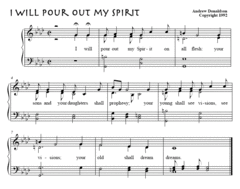 In a class I'm teaching on Crafting Language for Worship, we recently had a discussion about the value of significant words and repeated phrases in worship. Some of my students from evangelical and free-church traditions reported with delight the value they have discovered in the the persistent Easter season call-and-response "Christ is risen! Alleluia!/He is risen indeed, Alleluia!" They report that using this refrain now is profoundly formative, reminding them of the catholicity of the church, and connecting them with the faithful of so many times and places.
In a class I'm teaching on Crafting Language for Worship, we recently had a discussion about the value of significant words and repeated phrases in worship. Some of my students from evangelical and free-church traditions reported with delight the value they have discovered in the the persistent Easter season call-and-response "Christ is risen! Alleluia!/He is risen indeed, Alleluia!" They report that using this refrain now is profoundly formative, reminding them of the catholicity of the church, and connecting them with the faithful of so many times and places.
All of this reminded me of a time when my congregation practiced a fast from the use of the word "Alleluia" throughout the season of Lent in anticipation of its exuberant reintroduction to worship on Easter Sunday. Throughout the forty days, we still sang songs with "alleluia" in the lyrics, but self-consciously hummed "mm-mm-MM-mm" instead.
Meanwhile, the young children of the church spent one of their education hours creating colorful construction paper butterflies, decorated abundantly with the word "Alleluia." These were then crafted into a beautiful mobile, which debuted on Easter morning hanging high over the communion table, pointing to new life in Christ. Alleluia! He is risen!
Continue reading...


